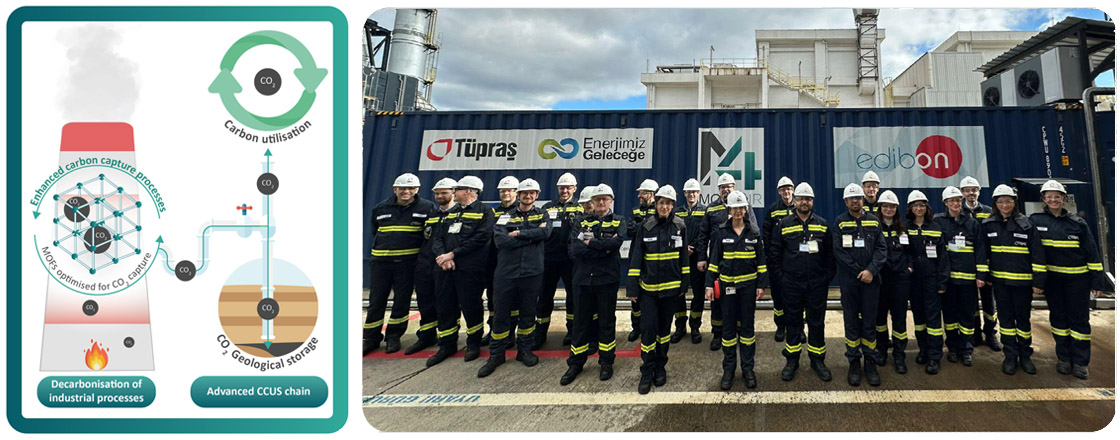Demonstration of optimised adsorption capture process using innovative porous materials (MOFs) on three industrial sites.
Carbon Capture Storage and Utilization (CCUS) is nowadays a societal need to reduce anthropogenic CO2 emissions, especially during the ongoing use of fossil fuels in the transitional phase towards renewable energies. CCUS is also essential where the use of renewable energy is difficult or impossible or when unavoidable CO2 emissions come from the process itself, e.g. the decarbonation reaction in the lime or cement sectors. The use of industrial CO2 as a carbon source in chemical production has been extensively investigated for a less carbonintensive and more sustainable chemical industry.
The amine-based CO2 absorption process, considered as a benchmark solution, suffers from several drawbacks including high energy penalties, solvent degradation, and toxicity. Among diverse separation technologies, adsorption emerges as a highly promising option due to its potential for reduced energy demand, lower cost, and a more favorable environmental impact compared to amine solvent absorption. Ongoing efforts involve the development of new materials to enhance the efficiency of this separation process.
Hybrid porous solids, a recent class of crystalline porous materials, commonly named Metal Organic Frameworks (MOFs) or Porous Coordination Polymers (PCPs) appear to be very promising, for gas separation and purification. These materials are highly tunable, offering quasi-infinite options for crystal structures and chemical compositions. This tunability allows for an extensive range of pore sizes, accessible surface areas, and diverse nature of specific adsorption sites. Combined with a low framework density, they emerge as attractive candidates for trapping gas species and a promising alternative compared to traditional materials like activated carbons or zeolites. However, the performance of these hybrid materials in carbon capture technologies must be assessed at a large scale and under real operating conditions.
Development of a suitable CO2 capture adsorbent should satisfy (1) high CO2 adsorption, (2) high CO2 selectivity, (3) low heat for regeneration, (4) fast kinetics, (5) thermal, chemical, and mechanical stabilities under extensive cycling capacity and (6) obviously low-cost green synthesis procedures.
Adsorption processes are widely established and employed at an industrial scale for activities such as air separation (production of O2 or N2), gas drying, and hydrogen purification. Their application for carbon capture still requires development to be optimised.
In this context, the H2020-MOF4AIR project gathering 14 partners from 8 countries aims to validate and demonstrate the interest of MOFs innovative porous materials combined with optimised capture processes on three demonstration sites. (https://www.mof4air.eu).

MOF4AIR partners have developed a model for designing VPSA (Vacuum Pressure Swing Adsorption) unit and selecting optimal operating conditions for specific applications by minimizing the energy consumption and the footprint.
The VPSA unit has undergone experimental validation in a relevant environment (TRL 5) at a lab-scale pilot (1-3 Nm³.h-1 of synthetic flue gas). Subsequently, the entire system is being fine-tuned and demonstrated on three different industrial sites (TRL6), employing a small-scale pilot (50-100 Nm³.h-1) to treat industrial flue gas (capturing 0.5 tons of CO2 per day): (i) TCM (Norway) is one of the most advanced and the largest post-combustion CO2 capture pilots. The MOF4AIR pilot will test the project's fine-tuned solution on two flue gases from Equinor Mongstad Refinery: Residual Fluid Catalytic Cracker (RFCC) and gas boiler (MHP); (ii) TUPRAS (Turkey) is the 7th largest refining capacity in Europe. The MOF4AIR pilot will be installed in the Izmit refinery. (iii) SOLAMAT-MEREX, member of Veolia Group (France). The MOF4AIR pilot will be operated in Marseille-Fos-sur-Mer hazardous waste incinerator.
To reach these ambitious objectives, 21 selected MOFs were produced at the g-scale in powder form and characterized extensively (measurements of CO2 adsorption/ desorption cycles under operating conditions, with contaminants (SO2, NOx, H2S) and water, mimicking real industrial processes conditions). Simulations were conducted under various conditions (dry/wet, several CO2 partial pressures, different temperatures).
Following this, five promising MOFs were selected based on their performances, stability, cost, environmental impact, and potential for large-scale production. These MOFs were scaled up to 500 g, shaped, fully characterized, and their adsorption properties assessed. Two MOFs were further chosen for synthesis and shaping at 3-5 kg scale. These MOFs underwent shaping with different binders, and their adsorption properties were investigated: (i) pure CO2 and N2 adsorption isotherm experimental measurements; (ii) stability against water and contaminants; (iii) breakthrough curve measurements.
Based on the obtained results and considerations such as ligand price and availability, one MOF has been selected for testing in VPSA at both lab-scale and industrial pilot scale, while another has undergone testing at the lab-scale in an alternative configuration: MBTSA (Moving Bed Thermal Swing Adsorption).
Modelling confirmed the promising results of one of the two MOFs, demonstrating CO2 purity and recovery higher than the targets (95% for purity and 90% for recovery) using MBTSA process. Simulation with the second MOF as an adsorbent enabled the selection of the optimal bed/ column configuration to meet the process targets in the VPSA process.
Both MOFs underwent testing in labscale pilots. Concerning MBTSA, first measurements were conducted, but further developments are still needed. Regarding the VPSA, the lab-scale pilot validated the promising results determined through simulation for the selected MOF. Additionally, some requirements were highlighted and will be considered for the operation of industrial pilots. The MOF4AIR pilot on TCM has begun its operation.
